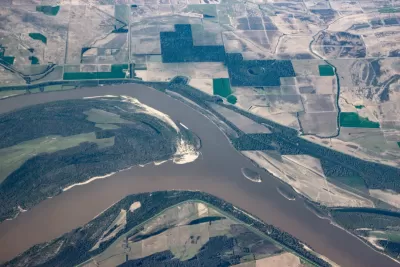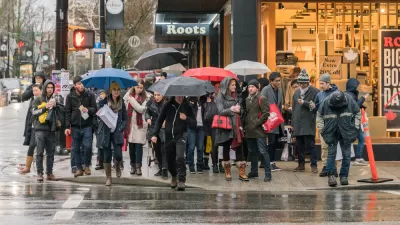It makes more fiscal sense to buy flood-prone land and conserve it than to cover the costs of the damages to developments, according to researchers from the University of Bristol and other institutions.

"Keeping vacant, flood-prone lands free of development could save taxpayers billions," writes Eli Chen, sharing the findings of new research published recently in the journal Nature Sustainability.
The study "found that every $1 spent acquiring undeveloped properties in the 100-year floodplain — which have a 1% chance of flooding in any given year — returns $5 that would be spent on emergency services, flood insurance claims and other flood damage costs if those properties became developed."
"As the number of people living in flood-prone regions like St. Louis is increasing, local governments should consider protecting undeveloped floodplain properties instead of building on them, said Barbara Charry, the floodplain and nature-based solutions strategy manager for the Nature Conservancy’s Missouri chapter."
To find solutions to the challenges of making that vision a reality, the Nature Conservancy is working with the Army Corps of Engineers "to develop a plan to improve floodplain management for the eight municipalities along the lower Meramec River," reports Chen.
Historic floods inundated the Mississippi River watershed during last year's rainy season.
FULL STORY: Cities Buying Empty Lots In Flood-Prone Areas Could Save Taxpayers Money, Study Claims

Study: Maui’s Plan to Convert Vacation Rentals to Long-Term Housing Could Cause Nearly $1 Billion Economic Loss
The plan would reduce visitor accommodation by 25,% resulting in 1,900 jobs lost.

North Texas Transit Leaders Tout Benefits of TOD for Growing Region
At a summit focused on transit-oriented development, policymakers discussed how North Texas’ expanded light rail system can serve as a tool for economic growth.

Why Should We Subsidize Public Transportation?
Many public transit agencies face financial stress due to rising costs, declining fare revenue, and declining subsidies. Transit advocates must provide a strong business case for increasing public transit funding.

How to Make US Trains Faster
Changes to boarding platforms and a switch to electric trains could improve U.S. passenger rail service without the added cost of high-speed rail.

Columbia’s Revitalized ‘Loop’ Is a Hub for Local Entrepreneurs
A focus on small businesses is helping a commercial corridor in Columbia, Missouri thrive.

Invasive Insect Threatens Minnesota’s Ash Forests
The Emerald Ash Borer is a rapidly spreading invasive pest threatening Minnesota’s ash trees, and homeowners are encouraged to plant diverse replacement species, avoid moving ash firewood, and monitor for signs of infestation.
Urban Design for Planners 1: Software Tools
This six-course series explores essential urban design concepts using open source software and equips planners with the tools they need to participate fully in the urban design process.
Planning for Universal Design
Learn the tools for implementing Universal Design in planning regulations.
City of Santa Clarita
Ascent Environmental
Institute for Housing and Urban Development Studies (IHS)
City of Grandview
Harvard GSD Executive Education
Toledo-Lucas County Plan Commissions
Salt Lake City
NYU Wagner Graduate School of Public Service




























